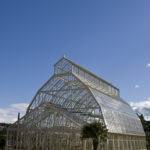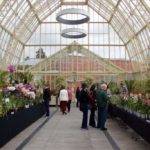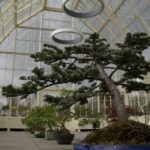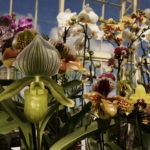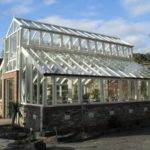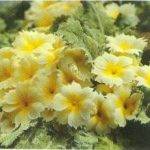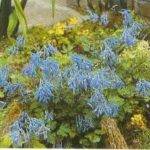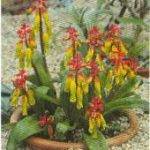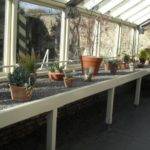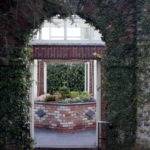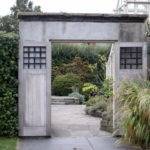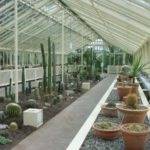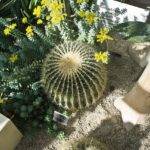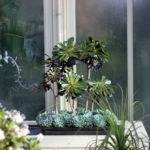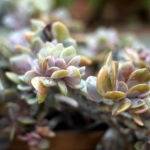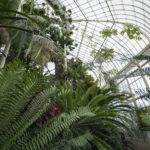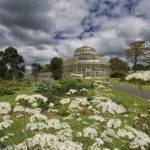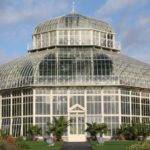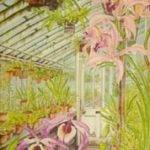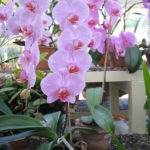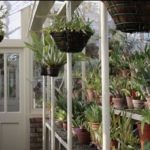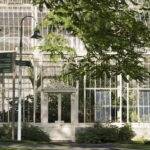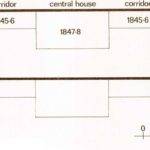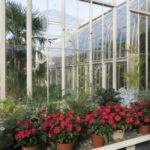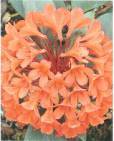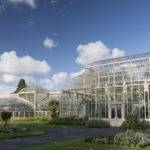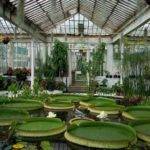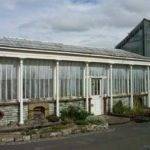The National Botanic Gardens is famous for its beautifully restored and planted glasshouses.
The Turner Curvilinear Range and the Great Palm House are both recipients of the Europa Nostra Award for excellence in conservation architecture. The glasshouses are open every day throughout the year except for Christmas Day, and are completely free to enter and explore. Interpretative guided tours are available Monday to Saturday for a small fee, and are free on Sundays. Click here for information on opening hours, and here for information about tours.
Scroll to end of this page for a map showing the location of each sight.
The Teak House
- The Teak House and the Orchid Fair. Courtesy of Poilin Nic Geidigh for DITSU.tv
- Bonsai Exhibition in the Teak House. OPW
- Annual Orchid Fair in the Teak House. OPW
The Alpine House
A constantly changing display of Alpine plants provides interest throughout the years in the Alpine House and Alpine Yard.
The Cactus and Succulent House
This glasshouse has also been known as the Flowering House, but is currently holding the Cactus and Succulent collection while their original house is undergoing restoration works.
The Great Palm House
Built in 1883 when the previous glasshouse was damaged in a storm, the ironwork was fabricated in Glasgow, Scotland and transported to Glasnevin. A faithful restoration by the Office of Public Works was begun in 2002. The restored house was opened by an Taoiseach in 2004.
The Orchid House
Orchids have a special place at Glasnevin. It was here, in the 1840s that orchids were first grown to flowering stage from seed by the curator, David Moore. The orchid house was restored along with the great Palm House in 2004. In addition, a number of species of tropical orchid were scientifically described from specimens growing in the Glasnevin collections; some of these were illustrated in Curtis’ Botanic Magazine, and are recorded in the National Botanic Gardens collections.
This print is by Susan Sex, who has been painting at the Gardens since 1996. She has been awarded gold medals for the years 2000 and 2001 for botanical illustration by the Royal Horticultural Society. The print is sold at the National Botanic Gardens in aid of the Trust fund. This fund aims to facilitate the research and educational work of the Gardens by assisting in the acquisition of archival material, aiding staff research and travel, the preservation of botanical books and illustrations and the development of an education programme.
The Curvilinear Range
This beautiful long, low range of glasshouses is built of iron and has a distinctive, curved roof. This style and method of construction was promoted by the celebrated Dublin iron-master Richard Turner; he was instrumental in having this range erected, and was largely responsible for its design. In the 1990s it was fully restored by the Office Of Public Works, with particular care being taken to restore the building faithfully in all its facets.
The east wing was constructed in 1843 by William Clancy, but the remaining sections were built by Richard Turner and his son William. The two extreme wings originally had brick walls at the back (i.e. down the middle of the existing houses), but in 1869 their size was doubled by adding a matching half to the wings. This is the most important building in the National Botanic Gardens, and its central dome was featured for many years on Irish stamps.
The plant collections within the house have three main themes.
In the Western Wing is a collection of plants from the mountains of South-East Asia, in particular Vireya Rhododendrons. The mountains of the Philippines, Borneo and New Guinea support a unique vegetation with many genera familiar to the Northern temperate zone. This house is dominated by species of Rhododendron from the section Vireya. Associated plants include tree ferns, orchids, pitcher plants and several unusual gymnosperm members, including Phyllocladus, Podocarpus and Agathis. Around the edge of the house are cultivated varieties of vireya Rhododendrons.
In the Eastern Wing are plants from the southern hemisphere, demonstrating the links between the Australian, South African and South American floras. The southern hemisphere continents of South America, South Africa, and Australia support a unique vegetation adapted to low rainfall and poor soils. Leaves are often thick, and filled with volatile oils (you will notice the strong aroma of essential oils in the house) both of which deter insect predation. As well as evolving in parallel, there are some striking links between these now well separated continents, notably in the plant families Proteaceae and Restionaceae. These links reflect a period of history 100 million years ago, when the continents were linked into a super-continent – Gondwanaland.
The Victoria Waterlily House
The Victoria waterlily house was designed by Duncan Ferguson, and built in 1854. About half the cost (£550) was raised by charging admission to a horticultural fete, which was held at the Gardens on the 24th June 1853. The house was was one of many built across Europe to house the botanical sensation of the time – Victoria amazonica, the Amazon waterlily. This gigantic waterlily was named in 1827, but it was not until 1849 that the first plant flowered at Chatsworth in England.
Until the 1920s, the west front of the building had elaborate finials above each column of the facade. The first Glasnevin plants were grown in 1849 and 1854 but did not flower. In 1855 seeds were donated from Oxford University Botanic Garden and these successfully flowered that year. In more recent years we have grown a different species – Victoria cruziana – which prefers somewhat cooler water temperatures, and has a taller rim to its leaves.
Unfortunately the Victoria Waterlily house has reached the end of its years, and is now ready for restoration. As a result we have not been able to grow the waterlily in recent years. Victoria cruziana was germinated in January of each year; by May a new leaf was added every five to eight days.

